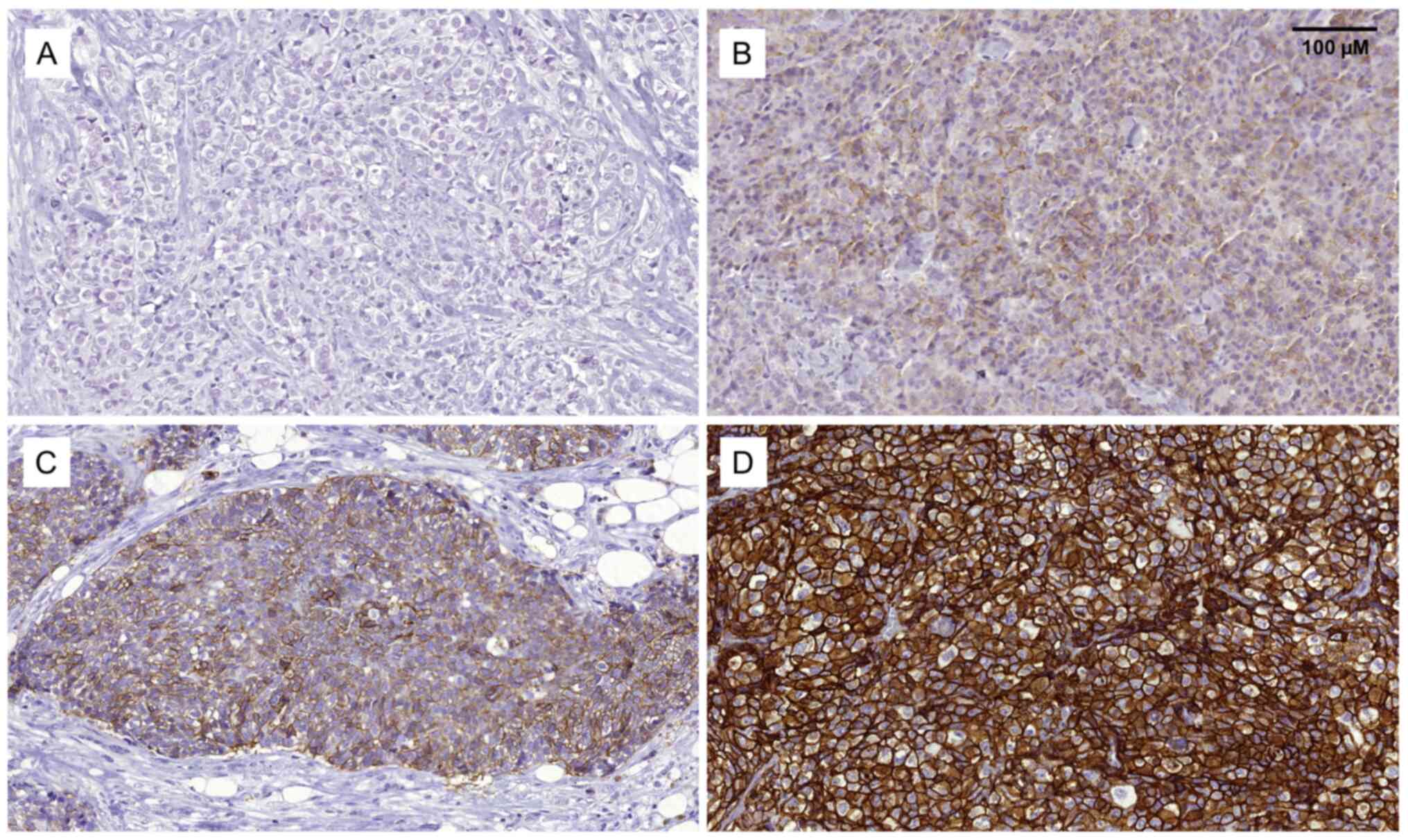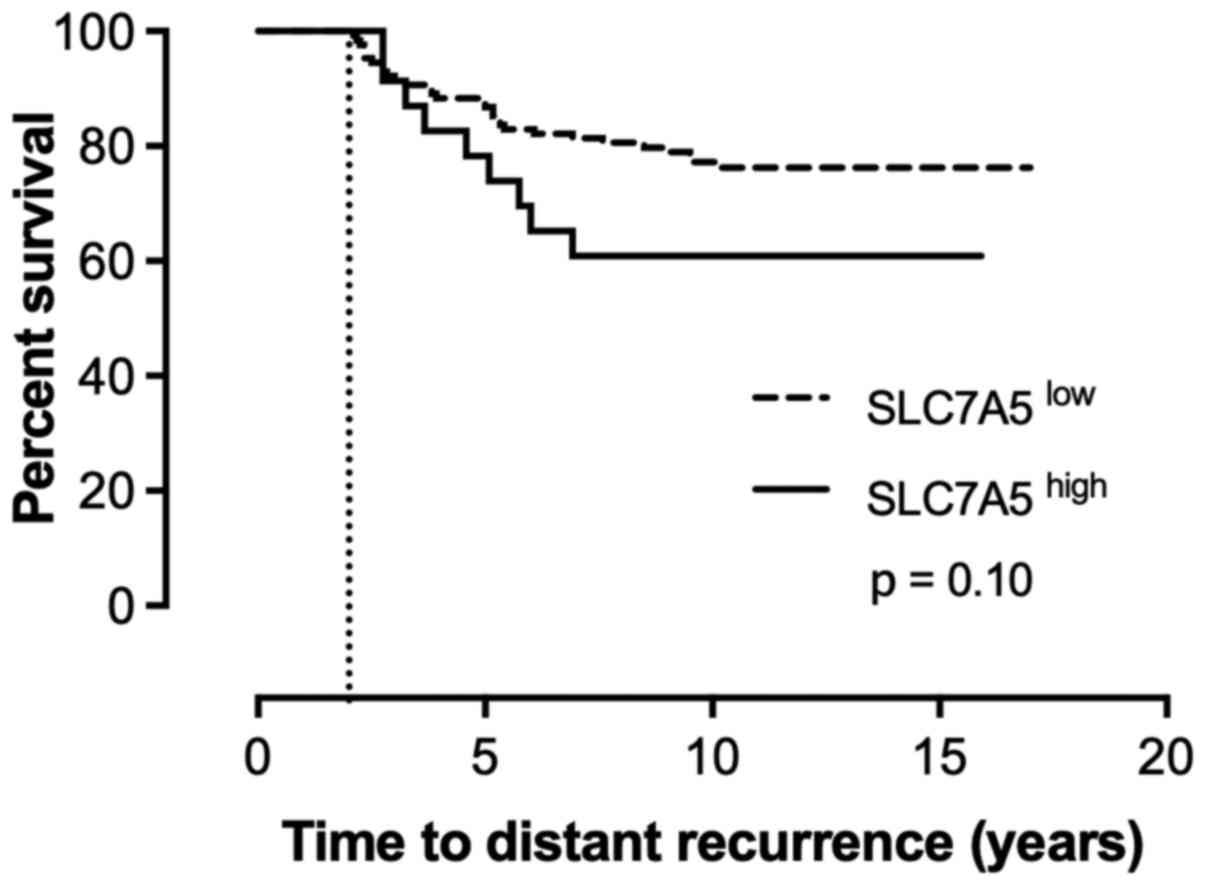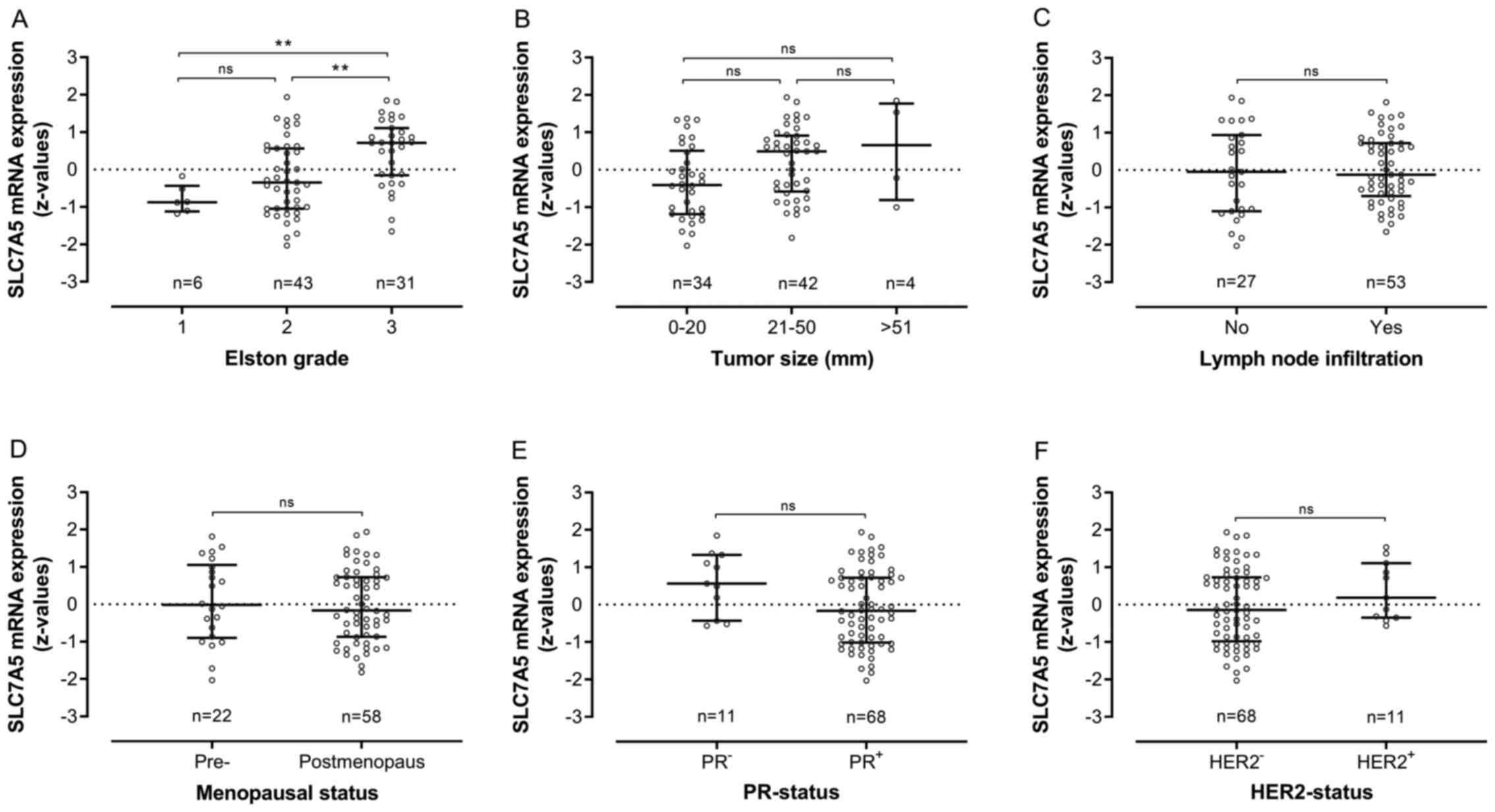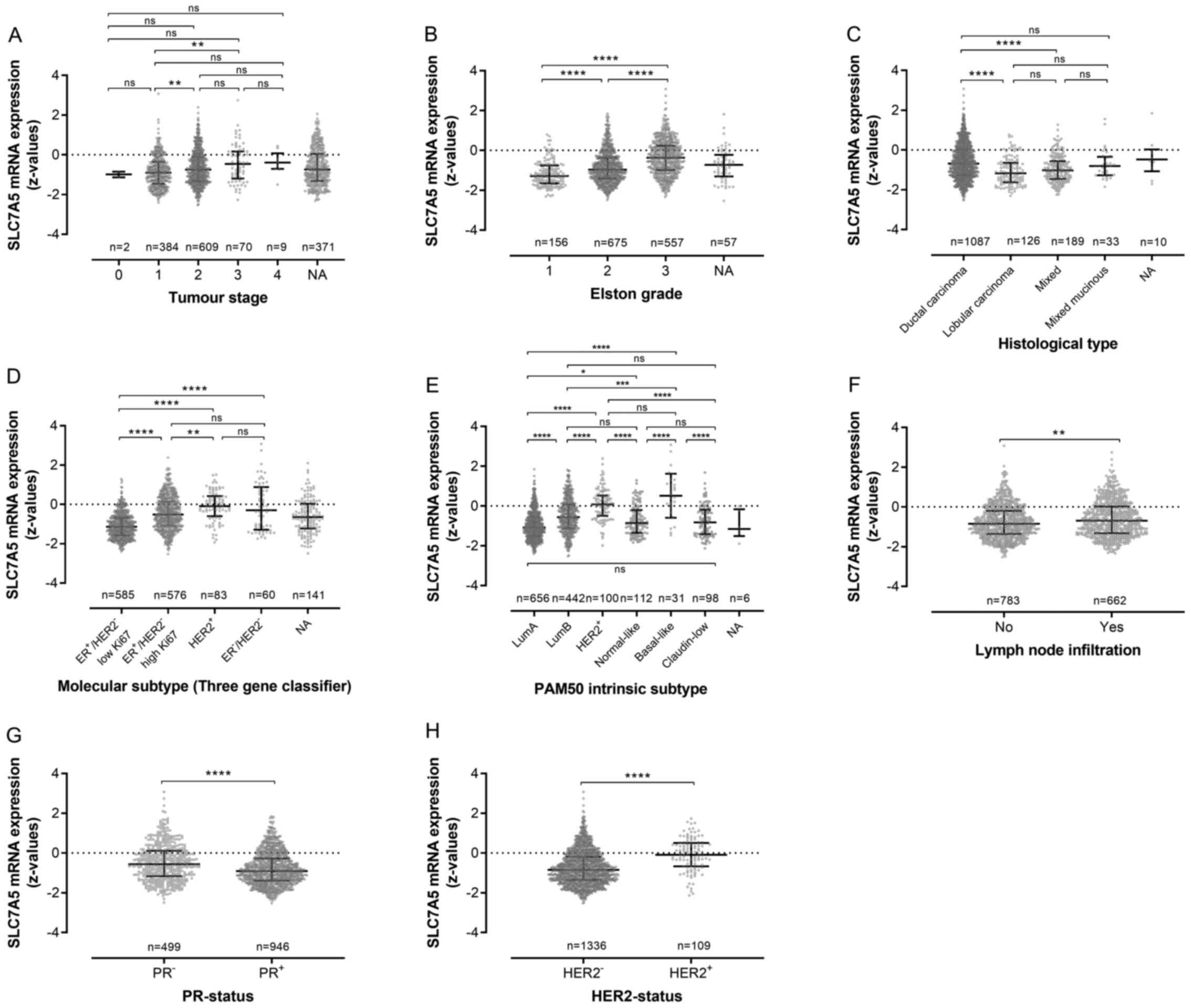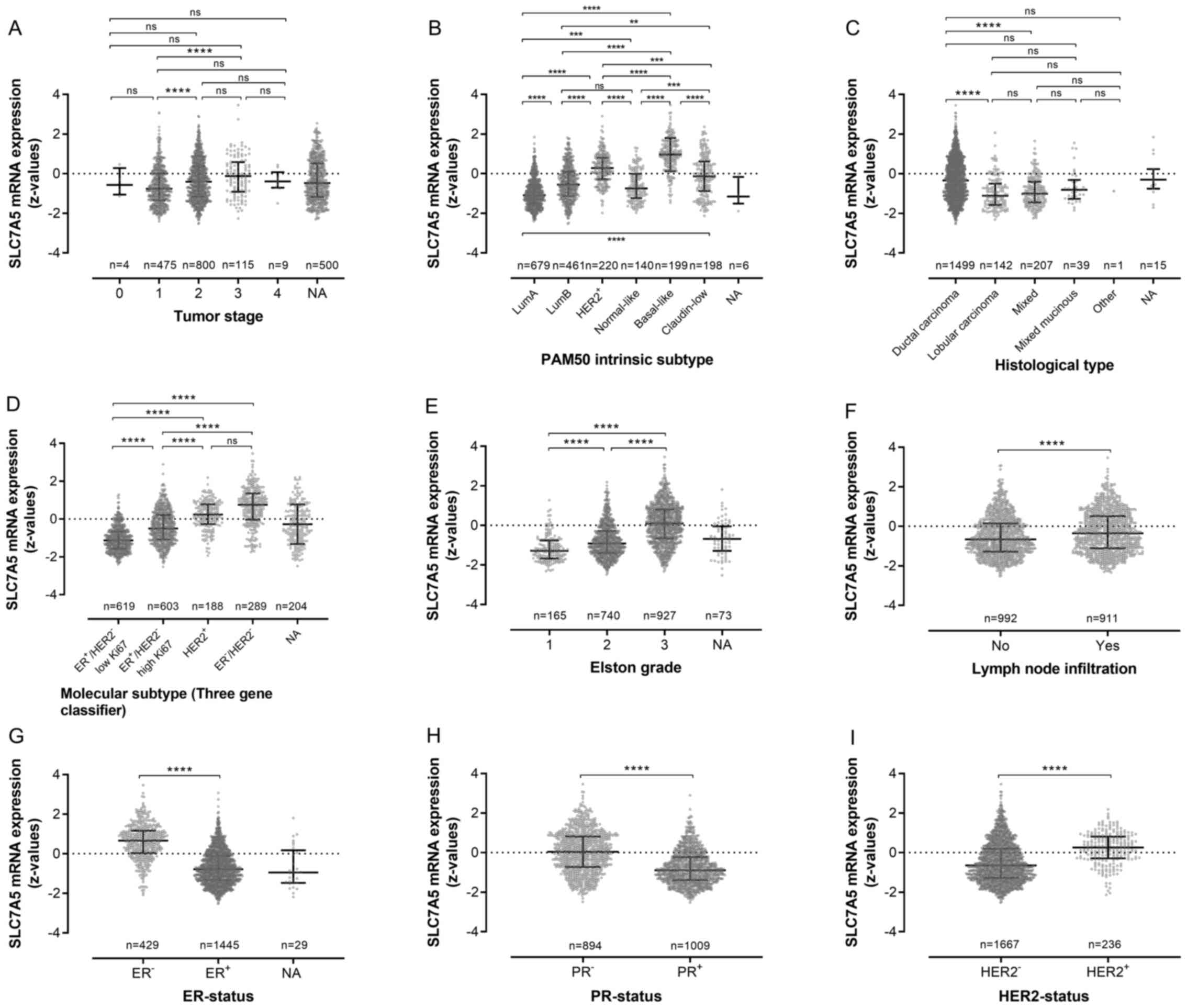|
1
|
Sung H, Ferlay J, Siegel RL, Laversanne M,
Soerjomataram I, Jemal A and Bray F: Global Cancer Statistics 2020:
GLOBOCAN estimates of incidence and mortality worldwide for 36
cancers in 185 countries. CA Cancer J Clin. 71:209–249. 2021.
View Article : Google Scholar : PubMed/NCBI
|
|
2
|
Goldhirsch A, Winer EP, Coates AS, Gelber
RD, Piccart-Gebhart M, Thürlimann B, Senn HJ, Albain KS, André F,
Bergh J, et al Panel members, : Personalizing the treatment of
women with early breast cancer: Highlights of the St Gallen
International Expert Consensus on the Primary Therapy of Early
Breast Cancer 2013. Ann Oncol. 24:2206–2223. 2013. View Article : Google Scholar : PubMed/NCBI
|
|
3
|
Harvey JM, Clark GM, Osborne CK and Allred
DC: Estrogen receptor status by immunohistochemistry is superior to
the ligand-binding assay for predicting response to adjuvant
endocrine therapy in breast cancer. J Clin Oncol. 17:1474–1481.
1999. View Article : Google Scholar : PubMed/NCBI
|
|
4
|
Duffy MJ, Harbeck N, Nap M, Molina R,
Nicolini A, Senkus E and Cardoso F: Clinical use of biomarkers in
breast cancer: Updated guidelines from the European Group on Tumor
Markers (EGTM). Eur J Cancer. 75:284–298. 2017. View Article : Google Scholar : PubMed/NCBI
|
|
5
|
El Sayed R, El Jamal L, El Iskandarani S,
Kort J, Abdel Salam M and Assi H: Endocrine and targeted therapy
for hormone-receptor-positive, HER2-negative advanced breast
cancer: Insights to sequencing treatment and overcoming resistance
based on clinical trials. Front Oncol. 9:5102019. View Article : Google Scholar : PubMed/NCBI
|
|
6
|
Häfliger P and Charles RP: The L-type
amino acid transporter LAT1 - An emerging target in cancer. Int J
Mol Sci. 20:24282019. View Article : Google Scholar : PubMed/NCBI
|
|
7
|
Scalise M, Galluccio M, Console L, Pochini
L and Indiveri C: The human SLC7A5 (LAT1): The intriguing
histidine/large neutral amino acid transporter and its relevance to
human health. Front Chem. 6:2432018. View Article : Google Scholar : PubMed/NCBI
|
|
8
|
Hanahan D and Weinberg RA: Hallmarks of
cancer: The next generation. Cell. 144:646–674. 2011. View Article : Google Scholar : PubMed/NCBI
|
|
9
|
Elorza A, Soro-Arnáiz I,
Meléndez-Rodríguez F, Rodríguez-Vaello V, Marsboom G, de Cárcer G,
Acosta-Iborra B, Albacete-Albacete L, Ordóñez A, Serrano-Oviedo L,
et al: HIF2α acts as an mTORC1 activator through the amino acid
carrier SLC7A5. Mol Cell. 48:681–691. 2012. View Article : Google Scholar : PubMed/NCBI
|
|
10
|
Gatenby RA, Smallbone K, Maini PK, Rose F,
Averill J, Nagle RB, Worrall L and Gillies RJ: Cellular adaptations
to hypoxia and acidosis during somatic evolution of breast cancer.
Br J Cancer. 97:646–653. 2007. View Article : Google Scholar : PubMed/NCBI
|
|
11
|
Salisbury TB and Arthur S: The regulation
and function of the L-type amino acid transporter 1 (LAT1) in
cancer. Int J Mol Sci. 19:23732018. View Article : Google Scholar : PubMed/NCBI
|
|
12
|
Adamaki M: Cancer and the cellular
response to hypoxia. Pediatr Ther. S1:0022012.
|
|
13
|
Cormerais Y, Giuliano S, LeFloch R, Front
B, Durivault J, Tambutté E, Massard PA, de la Ballina LR, Endou H,
Wempe MF, et al: Genetic disruption of the multifunctional
CD98/LAT1 complex demonstrates the key role of essential amino acid
transport in the control of mTORC1 and tumor growth. Cancer Res.
76:4481–4492. 2016. View Article : Google Scholar : PubMed/NCBI
|
|
14
|
Göthlin Eremo A, Lagergren K, Othman L,
Montgomery S, Andersson G and Tina E: Evaluation of
SPP1/osteopontin expression as predictor of recurrence in tamoxifen
treated breast cancer. Sci Rep. 10:14512020. View Article : Google Scholar : PubMed/NCBI
|
|
15
|
Tina E, Prosén S, Lennholm S, Gasparyan G,
Lindberg M and Göthlin Eremo A: Expression profile of the amino
acid transporters SLC7A5, SLC7A7, SLC7A8 and the enzyme TDO2 in
basal cell carcinoma. Br J Dermatol. 180:130–140. 2019. View Article : Google Scholar : PubMed/NCBI
|
|
16
|
Cerami E, Gao J, Dogrusoz U, Gross BE,
Sumer SO, Aksoy BA, Jacobsen A, Byrne CJ, Heuer ML, Larsson E, et
al: The cBio cancer genomics portal: An open platform for exploring
multidimensional cancer genomics data. Cancer Discov. 2:401–404.
2012. View Article : Google Scholar : PubMed/NCBI
|
|
17
|
Gao J, Aksoy BA, Dogrusoz U, Dresdner G,
Gross B, Sumer SO, Sun Y, Jacobsen A, Sinha R, Larsson E, et al:
Integrative analysis of complex cancer genomics and clinical
profiles using the cBioPortal. Sci Signal. 6:pl1. 2013. View Article : Google Scholar : PubMed/NCBI
|
|
18
|
Curtis C, Shah SP, Chin S-F, Turashvili G,
Rueda OM, Dunning MJ, Speed D, Lynch AG, Samarajiwa S, Yuan Y, et
al METABRIC Group, : The genomic and transcriptomic architecture of
2,000 breast tumours reveals novel subgroups. Nature. 486:346–352.
2012. View Article : Google Scholar : PubMed/NCBI
|
|
19
|
Rondón-Lagos M, Villegas VE, Rangel N,
Sánchez MC and Zaphiropoulos PG: Tamoxifen resistance: Emerging
molecular targets. Int J Mol Sci. 17:13572016. View Article : Google Scholar : PubMed/NCBI
|
|
20
|
Mihály Z, Kormos M, Lánczky A, Dank M,
Budczies J, Szász MA and Győrffy B: A meta-analysis of gene
expression-based biomarkers predicting outcome after tamoxifen
treatment in breast cancer. Breast Cancer Res Treat. 140:219–232.
2013. View Article : Google Scholar : PubMed/NCBI
|
|
21
|
El Ansari R, Craze ML, Miligy I,
Diez-Rodriguez M, Nolan CC, Ellis IO, Rakha EA and Green AR: The
amino acid transporter SLC7A5 confers a poor prognosis in the
highly proliferative breast cancer subtypes and is a key
therapeutic target in luminal B tumours. Breast Cancer Res.
20:212018. View Article : Google Scholar : PubMed/NCBI
|
|
22
|
Bodoor K, Almomani R, Alqudah M, Haddad Y
and Samouri W: LAT1 (SLC7A5) overexpression in negative Her2 group
of breast cancer: A potential therapy target. Asian Pac J Cancer
Prev. 21:1453–1458. 2020. View Article : Google Scholar : PubMed/NCBI
|
|
23
|
Guan Q, Song X, Zhang Z, Zhang Y, Chen Y
and Li J: Identification of tamoxifen-resistant breast cancer cell
lines and drug response signature. Front Mol Biosci. 7:5640052020.
View Article : Google Scholar : PubMed/NCBI
|
|
24
|
Bartlett JM, Thomas J, Ross DT, Seitz RS,
Ring BZ, Beck RA, Pedersen HC, Munro A, Kunkler IH, Campbell FM, et
al: Mammostrat as a tool to stratify breast cancer patients at risk
of recurrence during endocrine therapy. Breast Cancer Res.
12:R472010. View
Article : Google Scholar : PubMed/NCBI
|
|
25
|
Yan R, Zhao X, Lei J and Zhou Q: Structure
of the human LAT1-4F2hc heteromeric amino acid transporter complex.
Nature. 568:127–130. 2019. View Article : Google Scholar : PubMed/NCBI
|
|
26
|
Alfarsi LH, El-Ansari R, Craze ML, Masisi
BK, Mohammed OJ, Ellis IO, Rakha EA and Green AR: Co-expression
effect of SLC7A5/SLC3A2 to predict response to endocrine therapy in
oestrogen-receptor-positive breast cancer. Int J Mol Sci.
21:14072020. View Article : Google Scholar : PubMed/NCBI
|
|
27
|
El-Ansari R, Craze ML, Alfarsi L, Soria D,
Diez-Rodriguez M, Nolan CC, Ellis IO, Rakha EA and Green AR: The
combined expression of solute carriers is associated with a poor
prognosis in highly proliferative ER+ breast cancer.
Breast Cancer Res Treat. 175:27–38. 2019. View Article : Google Scholar : PubMed/NCBI
|
|
28
|
Semenza GL: Targeting HIF-1 for cancer
therapy. Nat Rev Cancer. 3:721–732. 2003. View Article : Google Scholar : PubMed/NCBI
|
|
29
|
Kaira K, Oriuchi N, Imai H, Shimizu K,
Yanagitani N, Sunaga N, Hisada T, Tanaka S, Ishizuka T, Kanai Y, et
al: l-type amino acid transporter 1 and CD98 expression in primary
and metastatic sites of human neoplasms. Cancer Sci. 99:2380–2386.
2008. View Article : Google Scholar : PubMed/NCBI
|
|
30
|
Semenza GL: HIF-1: Mediator of
physiological and pathophysiological responses to hypoxia. J Appl
Physiol (1985). 88:1474–1480. 2000. View Article : Google Scholar : PubMed/NCBI
|
|
31
|
Rathmell WK and Chen S: VHL inactivation
in renal cell carcinoma: Implications for diagnosis, prognosis and
treatment. Expert Rev Anticancer Ther. 8:63–73. 2008. View Article : Google Scholar : PubMed/NCBI
|
|
32
|
Lock FE, McDonald PC, Lou Y, Serrano I,
Chafe SC, Ostlund C, Aparicio S, Winum JY, Supuran CT and Dedhar S:
Targeting carbonic anhydrase IX depletes breast cancer stem cells
within the hypoxic niche. Oncogene. 32:5210–5219. 2013. View Article : Google Scholar : PubMed/NCBI
|
|
33
|
Valvona CJ, Fillmore HL, Nunn PB and
Pilkington GJ: The regulation and function of lactate dehydrogenase
A: Therapeutic potential in brain tumor. Brain Pathol. 26:3–17.
2016. View Article : Google Scholar : PubMed/NCBI
|
|
34
|
Szablewski L: Expression of glucose
transporters in cancers. Biochim Biophys Acta. 1835:164–169.
2013.PubMed/NCBI
|
|
35
|
Vander Heiden MG, Cantley LC and Thompson
CB: Understanding the Warburg effect: The metabolic requirements of
cell proliferation. Science. 324:1029–1033. 2009. View Article : Google Scholar : PubMed/NCBI
|
|
36
|
Swietach P, Hulikova A, Vaughan-Jones RD
and Harris AL: New insights into the physiological role of carbonic
anhydrase IX in tumour pH regulation. Oncogene. 29:6509–6521. 2010.
View Article : Google Scholar : PubMed/NCBI
|
|
37
|
Lou Y, McDonald PC, Oloumi A, Chia S,
Ostlund C, Ahmadi A, Kyle A, Auf dem Keller U, Leung S, Huntsman D,
et al: Targeting tumor hypoxia: Suppression of breast tumor growth
and metastasis by novel carbonic anhydrase IX inhibitors. Cancer
Res. 71:3364–3376. 2011. View Article : Google Scholar : PubMed/NCBI
|
|
38
|
Sato M, Harada-Shoji N, Toyohara T, Soga
T, Itoh M, Miyashita M, Tada H, Amari M, Anzai N, Furumoto S, et
al: L-type amino acid transporter 1 is associated with
chemoresistance in breast cancer via the promotion of amino acid
metabolism. Sci Rep. 11:5892021. View Article : Google Scholar : PubMed/NCBI
|
|
39
|
Saito Y, Li L, Coyaud E, Luna A, Sander C,
Raught B, Asara JM, Brown M and Muthuswamy SK: LLGL2 rescues
nutrient stress by promoting leucine uptake in ER+
breast cancer. Nature. 569:275–279. 2019. View Article : Google Scholar : PubMed/NCBI
|















